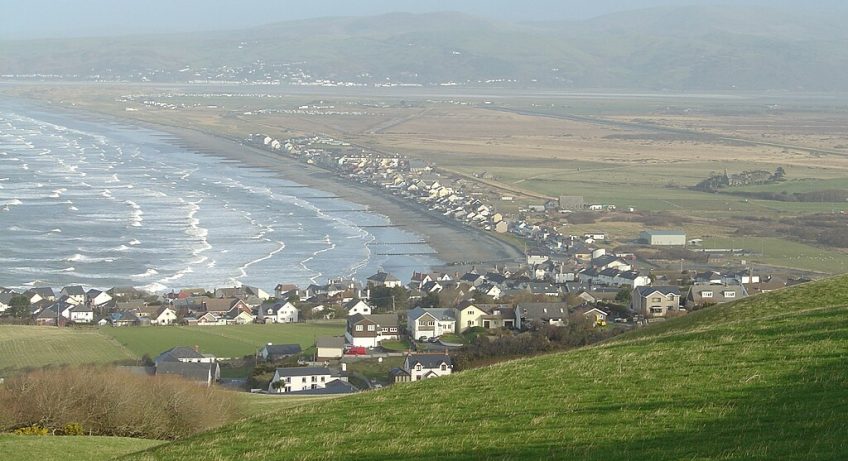Borth is a small fishing village and seaside resort. Located in Ceredigion, the village lies only 7 miles north of Aberystwyth and is a great secluded spot for wildlife watching and hikes.
In 2011, the population was only 1,399.
History
Throughout history, Borth has remained constant as a historic fishing village in Mid Wales.
Surrounding towns have experienced growth from coal and slate industries in the last couple of centuries which, in turn, have trickled growth into the village of Borth. In the last couple of decades, the village has been at the centre of conservation efforts due to its diverse habitats along the coast and in nearby Ynyslas.
Borth hosted the square festival until 2009. The festival lost its license amid disorder and safety concerns; the organisers were also struggling with financial issues that ultimately sunk the festival.
The beach
This quaint village is also a seaside resort, complete with caravan parks, camping facilities and sandy beaches.
Borth contains Ceredigion’s longest and, potentially, most golden beaches. Borth beach stretches two to three miles along the coastline, extending to Ynyslas and Dyfi National Nature Reserve. The beach has achieved blue flag status, making it a great spot for swimming, surfing, fishing and even windsurfing. Dogs are allowed full access to the beach between October and April.
Hidden petrified forest
One of the most interesting parts of Borth is the underwater petrified forest. When the tide goes out, the stumps of ancient trees are visible from the beach. They were discovered quite recently, during the first phase of a coastal protection scheme; Radiocarbon dating has revealed that this ancient forest dates back to 1500 BC.
Legends
This sunken kingdom, the ‘Atlantis’ of Wales, is the centre of the Cantre’r Gwaelod myth (the sunken hundred.) Intertwined with folklore and literature, there are two versions of this myth.
The story was first featured in the Black Book of Carmarthen: in this version of the myth, a well-maiden known as Mererid abandoned her duties and allowed the well to overflow. The more popular version of the myth, from the 17th century, centres around a prince called Seithenyn. The guardian of sea defences, he neglected the gate. Water flowed through, submerging the kingdom for good. In both versions, the mythical land sunk; these preserved trees are all that remain.
Wildlife
Borth’s quiet setting allows wildlife to thrive undisturbed, and there are multiple nature hotspots in the area.
Cors Fochno
Cors Fochno is a large raised peat bog just northeast of the village. Originally a 652-acre complex, much of the peat is now used for agriculture. However, some of it has been preserved as part of the Dyfi National nature reserve. This area hosts a variety of peat moss species and carnivorous plants; it attracts a variety of wildlife, including the Rosy Marsh Moth, a very rare species. Cors Fochno is also a good spot for birdwatching.
Dyfi National Nature Reserve
Cors Fochno is part of the larger Dyfi National Nature Reserve. This extensive reserve stretches along the coast to Ynyslas and contains a collection of vastly different environments, including mud flats, peat bog and a complex sand dune system.
Cors Dyfi
A little further out, to the northeast, lies Cors Dyfi. This reserve is best known for its family of nesting ospreys.
Hiking:
Footpaths and little trails are scattered throughout these nature reserves, as well as through the town itself.
The Ceredigion Coastal Path
The Ceredigion coastal path is a long-distance footpath that runs 65 miles along the Welsh coast, incorporating many seaside towns in its progress. Ynyslas, just a few miles north of Borth, is the official end of this long route.
You can jump on this coastal path at Borth and follow 6.5 miles of the route to Aberystwyth. This relatively easy walk takes approximately four hours and 30 minutes. You could also take a leisurely cycle along this path.
Dyfi Valley Way
Dyfi Valley Way is an alternate walking route, a long-distance footpath that starts (or ends) in Borth. The path runs 108 miles along the River Dyfi and crosses the village.
Culture:
Borth Station Museum
Tucked away inside Borth railway station is a little museum. The Borth Station Museum is bursting with historical artefacts that encompass the significance of local railways for agriculture, mining and tourist industries. The history showcased in this museum is broad and covers the local towns and villages. Temporary exhibitions provide a greater understanding of the wider community.
The museum is run by volunteers.
Oriel Adrift gallery
This family-run, independent art gallery contains a wide collection of art, from oil paintings to driftwood sculptures. Kevin & Valerie McArdell, who founded the gallery in 1992, wanted to champion and spotlight the work of local artists.
Where to eat and drink
The village has a mix of popular cafes, restaurants and pubs. Popular spots include the restaurant Libanus 1877 and the cafe Oriel Tir A Môr Gallery, both located on the high street.

